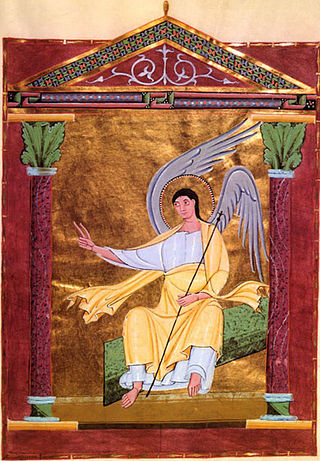
The Pericopes of Henry II is a luxurious medieval illuminated manuscript made for Henry II, the last Ottonian Holy Roman Emperor, made c. 1002–1012 AD. The manuscript, which is lavishly illuminated, is a product of the Liuthar circle of illuminators, who were working in the Benedictine Abbey of Reichenau, which housed a scriptorium and artists' workshop that has a claim to having been the largest and artistically most influential in Europe during the late 10th and early 11th centuries. An unrivalled series of liturgical manuscripts was produced at Reichenau under the highest patronage of Ottonian society.

Pre-Romanesque art and architecture is the period in European art from either the emergence of the Merovingian kingdom in about 500 AD or from the Carolingian Renaissance in the late 8th century, to the beginning of the 11th century Romanesque period. The term is generally used in English only for architecture and monumental sculpture, but here all the arts of the period are briefly described.

Ottonian art is a style in pre-romanesque German art, covering also some works from the Low Countries, northern Italy and eastern France. It was named by the art historian Hubert Janitschek after the Ottonian dynasty which ruled Germany and northern Italy between 919 and 1024 under the kings Henry I, Otto I, Otto II, Otto III and Henry II. With Ottonian architecture, it is a key component of the Ottonian Renaissance. However, the style neither began nor ended to neatly coincide with the rule of the dynasty. It emerged some decades into their rule and persisted past the Ottonian emperors into the reigns of the early Salian dynasty, which lacks an artistic "style label" of its own. In the traditional scheme of art history, Ottonian art follows Carolingian art and precedes Romanesque art, though the transitions at both ends of the period are gradual rather than sudden. Like the former and unlike the latter, it was very largely a style restricted to a few of the small cities of the period, and important monasteries, as well as the court circles of the emperor and his leading vassals.

Reichenau Abbey was a Benedictine monastery on Reichenau Island. It was founded in 724 by the itinerant Saint Pirmin, who is said to have fled Spain ahead of the Moorish invaders, with patronage that included Charles Martel, and, more locally, Count Berthold of the Ahalolfinger and the Alemannian Duke Santfrid I (Nebi). Pirmin's conflict with Santfrid resulted in his leaving Reichenau in 727.

The Morgan Beatus is an illuminated manuscript with miniatures by the artist Magius of the Commentary on the Book of the Apocalypse by the eighth-century Spanish monk Beatus, which described the end of days and the Last Judgment. Having been created at some time in the 10th century, the Morgan Beatus is one of the oldest examples of a revived Spanish apocalypse tradition. According to the style it was created by Mozarabs. The Apocalypse and the commentary on this scripture by Saint Beatus of Liébana became one of the most important religious texts of the Middle Ages, and was often illustrated very fully.

The Ottonian Renaissance was a renaissance of Byzantine and Late Antique art in Central and Southern Europe that accompanied the reigns of the first three Holy Roman Emperors of the Ottonian dynasty: Otto I (936–973), Otto II (973–983), and Otto III (983–1002), and which in large part depended upon their patronage. The leading figures in this movement were Pope Sylvester II and Abbo of Fleury.
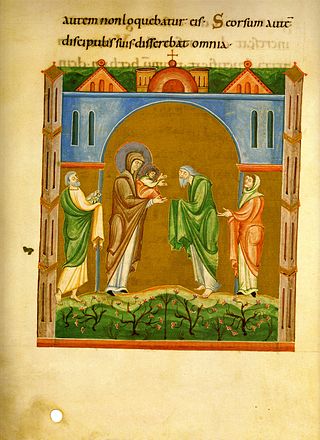
The Salzburg Pericopes is a medieval Ottonian illuminated gospel pericopes made c. 1020 at St. Peter's Monastery, Salzburg, during the reign of Henry II, the last Ottonian Holy Roman Emperor. It was made for Hartwig von Ortenburg, Archbishopric of Salzburg.

Egbert was the Archbishop of Trier from 977 until his death.

The Gospels of Otto III is considered a superb example of Ottonian art because of the scope, planning, and execution of the work. The book has 276 parchment pages and has twelve canon tables, a double page portrait of Otto III, portraits of the four evangelists, and 29 full page miniatures illustrating scenes from the New Testament. The cover is the original, with a tenth-century carved Byzantine ivory inlay representing the Dormition of the Virgin. Produced at the monastery at Reichenau Abbey in about 1000 CE., the manuscript is an example of the highest quality work that was produced over 150 years at the monastery.
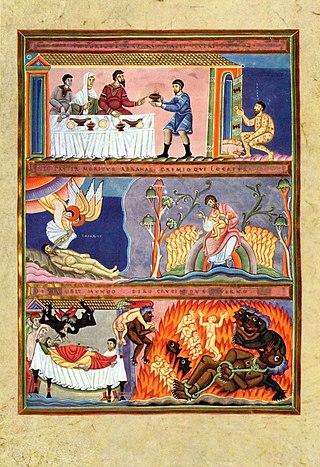
The Codex Aureus of Echternach is an illuminated Gospel Book, created in the approximate period 1030–1050, with a re-used front cover from around the 980s. It is now in the Germanisches Nationalmuseum in Nuremberg.

Commentary on the Apocalypse is a book written in the eighth century by the Spanish monk and theologian Beatus of Liébana (730–785) and copied and illustrated in manuscript in works called "Beati" during the 10th and 11th centuries AD. It is a commentary on the New Testament Apocalypse of John or Book of Revelation. It also refers to any manuscript copy of this work, especially any of the 27 illuminated copies that have survived. It is often referred to simply as the Beatus. The historical significance of the Commentary is made even more pronounced since it included a world map, which offers a rare insight into the geographical understanding of the post-Roman world. Well-known copies include the Morgan, the Saint-Sever, the Gerona, the Osma and the Madrid Beatus codices.

The Liuthar Gospels are a work of Ottonian illumination which are counted among the masterpieces of the period known as the Ottonian Renaissance. The manuscript, named after a monk called Liuthar, was probably created around the year 1000 at the order of Otto III at the Abbey of Reichenau and lends its name to the Liuthar Group of Reichenau illuminated manuscripts. The backgrounds of all the images are illuminated in gold leaf, a seminal innovation in western illumination.
The Sainte-Chapelle Gospels or the Sainte-Chapelle Gospel Book is an Ottonian illuminated manuscript now housed in the Bibliothèque nationale de France in Paris as Latin 8851. It is made up of 156 parchment folios, in a 38.5 cm by 28 cm format, making it one of the largest manuscripts of its era. It includes miniatures such as the canon tables, Christ in majesty and the Four Evangelists. It is the work of the Master of the Registrum Gregorii, the most famous illuminator of the Ottonian Renaissance.

The Tábara Beatus or Beatus of Tábara is a 10th-century illuminated manuscript, containing the Commentary on the Apocalypse by Beatus of Liébana. It originated in the San Salvador de Tábara Monastery and is now held in Spain's National Historical Archive in Madrid under the catalogue number L.1097B. Only eight of its original hundred miniatures survive.
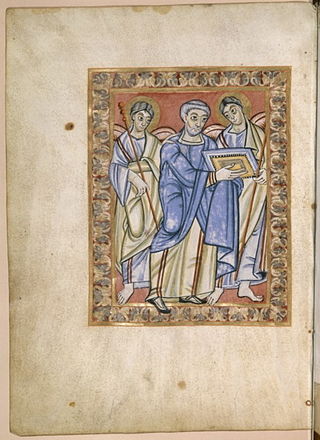
The Poussay Gospels is a 233-folio illuminated Gospel Book, produced around 980 in the scriptorium of Reichenau Abbey in southern Germany. It was given to a Benedictine convent in Poussay by its founder Berthold of Toul, who had been named bishop by Otto III, Holy Roman Emperor. Between 1025 and 1050 pope Leo IX gave the abbey a new binding for the work, including a Byzantine ivory plaque. After that abbey closed the manuscript entered the town library in Mirecourt, which in 1844 sold it to the Bibliothèque nationale de France for 3,000 francs 50 centimes in notes. It is still in the BNF, as Latin 10514. It was one of ten Ottonian manuscripts registered by UNESCO on the Memory of the World Register in 2003.
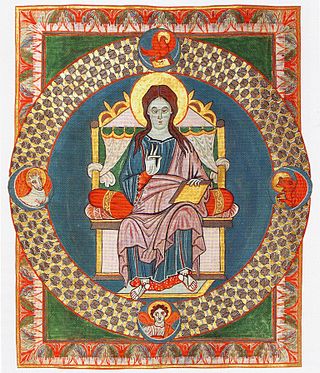
The Gero Codex or Gero-Codex is an Ottonian illuminated manuscript probably produced at Reichenau Abbey in Germany between 950 and 970. It is one of the first and most splendid of the Eburnant group of early Ottonian manuscripts.
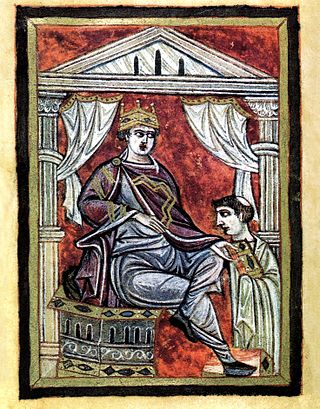
The Prayerbook of Otto III or Pommersfelden Prayerbook is an Ottonian illuminated manuscript, made up of 44 bound parchment folios. It was produced around 984 in Mainz for the private use of Otto III, Holy Roman Emperor, commissioned by his mother Theophanu and Archbishop Willigis. It is the only prayerbook to survive from the Ottonian era and its texts and images set out a monastic model for an ideal sovereign, making it more precisely a mirror of princes.

The Petershausen Sacramentary is an Ottonian illuminated manuscript of around 960–980, produced in the scriptorium of Reichenau Abbey and containing the sacramentary and liturgical calendar. It is now held in the Heidelberg University library.

The Cloisters Apocalypse, MS 68.174 is a small French illuminated manuscript dated c. 1330. It is based on John the Evangelist's New Testament visions and apocalyptic revelation. According to Christian legend John was exiled c. 95 CE to the Aegean island of Patmos, where he wrote the Book of Revelation. The book evokes John's despair and isolation while exiled, and his prophecy of events and terrors of the last days.

The Emperor's Bible, also known as Codex Caesareus, Codex Caesareus Upsaliensis or the Goslar Gospels, is an 11th-century illuminated manuscript currently in Uppsala University Library, Sweden. Despite its name, it is not a Bible but a Gospel Book. The book was made in the scriptorium of Echternach Abbey, and is one of four preserved large Gospel Books made there during the 11th century. It was commissioned by Emperor Henry III and donated by him to Goslar Cathedral, where it remained until the Thirty Years' War. It was then lost for about 100 years. Its previous richly decorated cover was also lost at this time at the latest. The book later appeared again in the possession of Swedish diplomat and civil servant Gustaf Celsing the Elder. At the death of his son, it was acquired by Uppsala University.



















